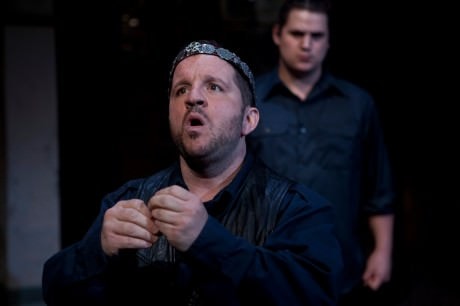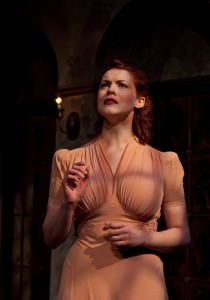After the discovery of Richard III’s remains in a Leicester car park in August 2012, it was concluded that far from being a hunchback, as some have stated, he suffered from scoliosis, an abnormal sideways curvature of the spine. He was, as Ross noted in his classic biography, small and slight (Richard III, Yale English Monarch, Yale University Press, 2011). At NextStop Theatre Company, Director Dr. Lindsey D. Snyder has created a Richard III in which Richard is actually deaf, reliant on American Sign Language and other men to communicate with the public, at the Court, and even in his own family. For Snyder, a perceived disability drives expectations, not only the expectations others might have of an individual, but the expectations that individual places on himself. American Sign Language, she says, is commonly marginalized as, “foreign, frightening or pretty, but meaningless.” In this production, other actors sometimes speak for Richard, interpreting his sign language; but there are certain characters, such as Tyrell, the hired murderer of the Princes, with whom Richard can sign when alone.

What does this mean for Ethan Sinnott’s interpretation of Richard? Mr. Sinnott is the Director of, and Associate Professor at, Gallaudet University’s Theatre program. He brings to the role of Richard a fierceness and determination that admirably suggests the forcefulness which Richard must have had in abundance. He can portray Richard’s glee at his murderous successes, as well as his deep frustration and anger when things fail to go his way. He is assisted with style and conviction by Sun King Davis (who also plays Buckingham) and Daniel Corey (who also plays Richmond) as well as some of the other actors. One quickly becomes used to Davis and the others as spokespersons for Richard, and in a way they are able to layer on another level of meaning to the acting by speaking Richard’s lines themselves.
In her essay, Enabling Richard: The Rhetoric of Disability in Richard III, (Disability Studies Quarterly), Karen Schapp Williams observes that while throughout the play Richard describes himself as “deformed” and Queen Margaret refers to him as “bottled spider,” Richard actually uses his physical differences to aid his rise to power by manipulating the meanings of monstrosity that swirl around him. It is true, as she notes, that in the Renaissance an outward deformity such as a hunchback implied inner depravity. Today, she views Richard as a “dismodern” subject; a phrase coined by Lennard Davis. “The dismodern subject,” she says, “challenges a binary of able/disabled bodies by assuming that everyone starts from a position of disability, thus dispensing with the narrative or modernity that insists upon an idealized, able-bodied subject whose full independence suggests perfectibility.”
As played by Professor Sinnott, Richard’s only disability is his deafness; but he uses every aspect of his body to strategize, and, in many cases, win. This provides an interesting new perspective on the Richard we love to hate.
Sun King Davis gives a strong, nuanced performance, both as Buckingham and as a spokesman for Richard. Daniel Corey is equally inventive and powerful, particularly in his last fight with Richard which is very well staged.
Zach Brewster-Geisz (Hastings/Lord Mayor/Messenger/Herbert) is a standout throughout. The condescending way in which he speaks to Richard is both funny and sad; a commentary on the way disabled people are sometimes treated. He handles his quadruple casting superbly, although it seemed to me a bit much that he was required as Lord Mayor to observe the presentation of his own severed head as Hastings.
Kevin Collins is very effective both as Clarence and Stanley; his joy at the survival of his son is particularly well-done and moving. Bill Fleming, who also revels in a multiplicity of roles (King Edward/Brakenbury/Rivers/Cardinal Ely), makes each one distinctive and intriguing. In his red costume as the Cardinal he would make a fine Wolsey—perhaps someone should cast him in Henry VIII and find out. Ben Lauer (Catesby/Murderer) is particularly skilled in the way he wrings meaning out of every line. Charles Ainsworth (Tyrell/Ratcliff) is memorably menacing, in some especially tense scenes.

Among the women, Carolyn Kashner gives a depth and complexity to Queen Elizabeth that makes her convincing and ultimately sympathetic. As Duchess of York, Marilyn Bennett has many excellent moments, especially when she ultimately rejects Richard. Mary Suib (Queen Margaret) makes the most of her many curses, and manages to make Margaret a figure of foreboding without, as they once said, chewing the scenery. Lady Anne is a notoriously difficult part, and Rachel Spicknall Mulford has a variety and truthfulness which carries her through even the most challenging scenes. As Grey she performs admirably, focusing on the business at hand even while playing a man’s part, never easy at the best of times.
It is hard to imagine the young and charming Sandra Mae Frank as a Murderer, but she carries out her acting duties exceptionally well. When, at the end of the play, when she unites with Richmond, they display a touching picture of young love which Shakespeare would probably have enjoyed.
The Princes were portrayed as babies; it would probably have been better to cast child actors, provided you could find them.
Scenic Designer JD Madsen’s work served the play effectively. Erin Nugent’s costumes were helpful in creating the tone of the piece; the contrast between the suits worn by the men in the beginning and their military gear later on worked well for the story. The Lighting Design (Sarah Tundermann), Sound Design (Stan Harris), and Property Design (Kristen Pilgrim) combined beautifully to enhance the underlying style of the production.
In January of this month, Godfrey Bloom, an MEP who was expelled from Ukip after describing women as “sluts” insulted a disabled student during a debate at the Oxford Union. The student, David Browne, called Mr. Bloom’s description of countries who receive aid as “Bongo Bongo Land” deplorable. Mr. Bloom then said, “Are you Richard III or not?” He insisted that Mr. Browne took the comment in good part, saying “We enjoyed a good drink and a laugh” afterwards. Mr. Browne is quoted as saying, “I didn’t think it was a very nice thing to say. I wasn’t happy with the remark.” (Godfrey Bloom mocks disabled student as ‘Richard III’ by Matthew Holehouse, The Telegraph, 1/27/14).
Once again Richard III is found to be startlingly relevant to our times. Productions like NextStop Theatre Company’s Richard III enhance our understanding and provide new and creative ways of looking at functionality.
Running Time: Two hours and 20 minutes, with one 15-minute intermission.
Richard III is playing through February 23, 2014 at NextStop Theatre Company – 269 Sunset Park Drive, Herndon, VA. For tickets, call (866) 811-4111, or purchase them online.





